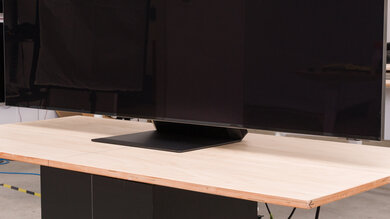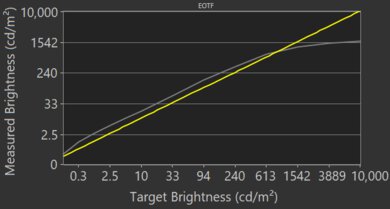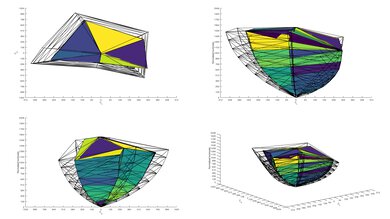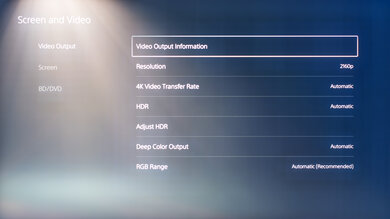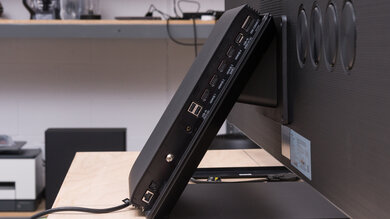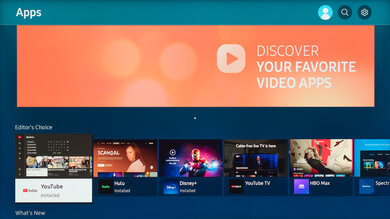The Samsung QN800A 8k QLED is a great TV overall. It's one of two 8k TVs from Samsung's 2021 Neo QLED lineup, and it features Mini LED backlighting. Despite its great overall performance, it's disappointing considering its premium lineup placement and price tag. Even though it has Mini LED backlighting with over 1300 dimming zones, its local dimming feature performs quite poorly. It helps improve the low contrast ratio but, at the same time, causes intense blooming around bright objects. This TV isn't the best choice for dark room viewing, but if you want to use it in a well-lit environment, it has high peak brightness and fantastic reflection handling. Gamers should appreciate its HDMI 2.1 and variable refresh rate (VRR) support, low input lag, and excellent response time, but some people may still notice some dark smearing with fast-moving content.
Our Verdict
The Samsung QN800A is great for most uses. It's an excellent choice for use in bright rooms, like when you're watching shows or sports, because it gets bright enough to combat glare and has fantastic reflection handling. It has great gaming features like VRR technology and HDMI 2.1 support. It also has very low input lag and an excellent response time. However, it struggles in dark rooms due to its low contrast ratio and poor local dimming feature that causes blooming around bright objects. It also doesn't display a wide color gamut for HDR content, but has fantastic brightness.
- Fantastic peak brightness in SDR and HDR.
- HDMI 2.1 support on all four ports.
- High 8k resolution helps deliver clear text and crisp images.
- Local dimming feature causes blooming around bright objects.
- Contrast ratio lower than most VA panel TVs.
- Can't display a wide color gamut.
The Samsung QN800A is good for watching movies. It has a VA panel with a decent contrast ratio that's lower than most VA panel TVs, causing blacks to look gray. Its full-array local dimming feature does a good job at improving the contrast for deep blacks, but it causes a ton of blooming. Luckily, the TV upscales lower-resolution content, like from Blu-rays, without many issues.
- Upscales lower-resolution content well.
- Automatically removes 24p judder from any source.
- Local dimming feature causes blooming around bright objects.
- Contrast ratio lower than most VA panel TVs.
The Samsung QN800A is impressive for watching TV shows. It gets bright enough to fight glare and has fantastic reflection handling, so visibility shouldn't be an issue in well-lit rooms. It doesn't have issues upscaling lower-resolution content like from cable boxes. Sadly, its viewing angles are a bit narrow, so you lose image accuracy when viewing at a wide angle.
- Upscales lower-resolution content well.
- Fantastic peak brightness in SDR and HDR.
- Remarkable reflection handling.
- Somewhat narrow viewing angles.
- Rainbow-like effect with reflections.
The Samsung QN800A is great for watching sports. Visibility shouldn't be an issue in well-lit rooms because of its fantastic reflection handling and high peak brightness. It has an excellent response time, but you may notice some motion blur with fast-moving sports. It has only okay viewing angles, so it's not suggested for really wide seating arrangements as you lose image accuracy.
- Fantastic peak brightness in SDR and HDR.
- Remarkable reflection handling.
- Motion looks smooth for the most part.
- Somewhat narrow viewing angles.
- Rainbow-like effect with reflections.
The Samsung QN800A is great for gaming. It has many of the popular gaming features like HDMI 2.1 and VRR support. Its input lag is incredibly low, and it has an excellent response time. Sadly, it's not the best for dark room gaming due to its lower contrast ratio and its bad 'Game Mode' local dimming feature that causes intense blooming around bright objects.
- Motion looks smooth for the most part.
- HDMI 2.1 support on all four ports.
- FreeSync VRR support.
- Local dimming feature causes blooming around bright objects.
- Contrast ratio lower than most VA panel TVs.
The Samsung QN800A is good for watching HDR movies. It has fantastic HDR brightness, so highlights pop the way the creator intended, but sadly, it doesn't display a wide color gamut. It's not a good choice for dark room viewing because it has a low native contrast ratio, and its full-array local dimming feature is poor as there's too much blooming around bright objects.
- Upscales lower-resolution content well.
- Fantastic peak brightness in SDR and HDR.
- Local dimming feature causes blooming around bright objects.
- Contrast ratio lower than most VA panel TVs.
- Can't display a wide color gamut.
The Samsung QN800A is great for HDR gaming. It delivers a responsive gaming experience thanks to its 120Hz panel, FreeSync support, low input lag, and an excellent response time. It has fantastic HDR peak brightness, but it doesn't display a wide color gamut. Also, it has a poor local dimming feature and combined with its low contrast ratio, doesn't deliver a good dark room experience.
- Upscales lower-resolution content well.
- HDMI 2.1 support on all four ports.
- FreeSync VRR support.
- Local dimming feature causes blooming around bright objects.
- Contrast ratio lower than most VA panel TVs.
- Can't display a wide color gamut.
The Samsung QN800A is an excellent choice to use as a PC monitor. It has a high 8k resolution that helps deliver clear text, and it displays proper chroma 4:4:4. It performs best when used in a well-lit room because it has fantastic reflection handling and high peak brightness. However, it has somewhat narrow viewing angles, so the image looks inaccurate at the sides if you sit too close.
- Fantastic peak brightness in SDR and HDR.
- Remarkable reflection handling.
- Motion looks smooth for the most part.
- High 8k resolution helps deliver clear text and crisp images.
- Somewhat narrow viewing angles.
- Rainbow-like effect with reflections.
Changelog
- Updated Sep 26, 2025: We uploaded the latest brightness measurements and uniformity photos for the Accelerated Longevity Test.
- Updated Jul 08, 2025: We uploaded the latest brightness measurements and uniformity photos for the Accelerated Longevity Test.
- Updated Apr 17, 2025: We uploaded the latest brightness measurements and uniformity photos for the Accelerated Longevity Test.
- Updated Feb 11, 2025: We uploaded the latest brightness measurements and uniformity photos for the Accelerated Longevity Test.
Check Price
Differences Between Sizes And Variants
We tested the 65 inch Samsung QN800A (QN65QN800A) variant, and for the most part, we expect our review to be valid for the 75 inch (QN75QN800A), and the 85 inch variants (QN85QN800A) available in North America. It's known as the Samsung QN850A at Costco and it's available in 75 and 85 inch sizes. We expect the QN800A in Europe to perform similarly, but we don't know for sure because Samsung's lineup is a bit different in Europe.
| Size | US | Costco | Canada | UK | Italy | Germany |
|---|---|---|---|---|---|---|
| 65" | QN65QN800AFXZA | - | QN65QN800AFXZC | QE65QN800ATXXU | QE65QN800ATXZT | GQ65QN800ATXZG |
| 75" | QN75QN800AFXZA | QN75QN850AFXZA | QN75QN800AFXZC | QE75QN800ATXXU | QE75QN800ATXZT | GQ75QN800ATXZG |
| 85" | QN85QN800AFXZA | QN85QN850AFXZA | QN85QN800AFXZC | QE85QN800ATXXU | - | GQ85QN800ATXZG |
If someone comes across a different type of panel or if their Samsung QN800A doesn't correspond to our review, let us know and we'll update the review. Note that some tests, like gray uniformity, may vary between units.
Our unit of the QN800A was manufactured in February 2021; you can see the label here.
Popular TV Comparisons
Considering its price point and place in Samsung's Neo QLED lineup, the Samsung QN800A is pretty disappointing. It fails to take advantage of its Mini LED backlighting as its local dimming feature performs poorly and causes too much blooming around bright objects. Also, there isn't much 8k content available, so if you're only going to watch 4k content, the Samsung QN90A QLED costs less and performs better.
See our recommendations for the best Samsung TVs, the best QLED TVs, and the best TVs for watching sports.
Despite having a lower resolution, the Samsung QN90A is much better overall than the Samsung QN800A 8k QLED. The main difference is the improved dark room performance. The QN90A displays a wider color gamut, has a much better contrast ratio, and has a far superior local dimming feature, as there's too much blooming around bright objects with the QN800A. The QN800A is an 8k TV, but since there isn't much 8k content available in 2021, it's worth getting the QN90A.
The Samsung QN900A 8K sits above the Samsung QN800A 8k QLED in Samsung's lineup. They're similar, but there are a few key differences. The QN900A has a slimmer construction with thinner bezels. It also has a better local dimming feature, but the QN800A gets a bit brighter overall in SDR and HDR and has a slightly faster response time.
The Samsung Q90/Q90T QLED is better overall than the Samsung QN800A 8k QLED. The main difference between the two is that the Q90T has a much better native contrast ratio and full-array local dimming feature, so it displays deeper blacks. The QN800A uses Mini LED backlighting, but there's too much blooming. The Q90T also has a quicker response time for smoother motion. The QN800A supports 8k signals, which the Q90T doesn't, but there's not much native 8k content available in 2021 anyways.
The Samsung QN800A 8k QLED and its predecessor, the Samsung Q800T 8k QLED, are great TVs with different strengths and weaknesses. The Q800T has a much better local dimming feature, making it a better choice for dark room gaming, and it displays a wider color gamut. However, the QN800A gets brighter, especially in Game Mode, so it's a better choice for bright room viewing. The QN800A displays 4k @ 120Hz content in HDR with the PS5, which the Q800T can't do. The QN800A is also slightly redesigned because it comes with a One Connect box, but other than that, they have many of the same features and performance.

We buy and test dozens of TVs yearly, taking an objective, data-driven approach to deliver results you can trust. Our testing process is complex, with hundreds of individual tests that take over a week to complete. Most of our tests are done with specially designed test patterns that mimic real content, but we also use the same sources you have at home to ensure our results match the real-world experience. We use two main tools for our testing: a Colorimetry Research CR-100 colorimeter and a CR-250 spectroradiometer.
Test Results

The Samsung QN800A is slightly redesigned from 2020's Samsung Q800T QLED, and it looks very premium. It comes with Samsung's One Connect box that houses all the inputs, so there's only one wire going to the TV. You can even attach the box to the stand or the back panel. There are speakers on the back panel, which some people may not like, but you won't notice it when watching TV anyways.
Unfortunately, the brightness of this TV decreased considerably between our initial measurements and the second month's measurements due to an automatic firmware update.
The center-mounted stand is similar to the stands on past Samsung TVs, except the TV sits a bit lower to the surface. It looks premium and supports the screen very well without much wobble.
Footprint of the 65" TV: 14.2" x 11.3". This measurement was taken without the One Connect box attached; with it, it has a depth of 12.9".
The back of the Samsung QN800A is a bit redesigned, and it's made from a mix of metal and plastic. There are speakers on either side, which is something we haven't seen on Samsung models in the past. You can either attach the One Connect box to the stand, directly on the back, or leave it on its own close to the TV. There's a plastic cover next to the box that serves as cable management.
The build quality of the Samsung QN800A is fantastic. The entire TV is well-put-together, and there isn't anything obvious that stands out. The back panel doesn't flex all that much and feels very solid. The TV wobbles just a bit, but that's somewhat expected due to its size and center-mounted stand.
The Samsung QN800A has a decent contrast ratio. VA panels like this one rarely have such a low native contrast ratio, but we saw the same thing with the Samsung Q800T QLED. This is because of Samsung's 'Ultra Viewing Angle' layer. However, the local dimming feature greatly improves the contrast to deliver deep blacks. Also, the local dimming feature can only be disabled through the service menu, so we expect most people to have it on while watching content.
Update 07/29/2021: We retested the peak brightness with the latest firmware available (1511). Most scenes are a bit brighter than before, but not noticeably so. The real scene peak brightness stayed the same.
The Samsung QN800A has fantastic peak brightness in SDR. It easily gets bright enough to combat glare even in the brightest lighting conditions. There isn't any frame dimming with the 2% window that we saw with the Samsung Q800T QLED either. However, the screen loses brightness when there are large, bright areas due to the Automatic Brightness Limiter (ABL). This is disappointing if you watch sports with a hockey rink or basketball court.
We tested brightness after calibration in the 'Movie' Picture Mode with Brightness at its max, Color Tone set to 'Warm2', and Local Dimming on 'High'. We got the brightest image with these settings, as seen in the 10% peak window.
Update 07/29/2021: We retested the local dimming feature with the latest firmware available (1511). The overall performance of the local dimming feature is about the same as before, but the blooming is a bit less noticeable, as the system is averaging out the brightness across more zones than before.
The Samsung QN800A has a poor local dimming feature. This is disappointing considering it's a high-end Mini LED TV with 1344 dimming zones, and it's not nearly as good as the Samsung QN90A QLED. It helps improve the contrast by making blacks look deep, but there's intense blooming around bright objects. It's noticeable in any content with bright objects, and it's very distracting. Subtitles are also hard to read because of it, and it causes some uniformity issues. The blooming is the main reason why we scored the local dimming so low. Other than that, there isn't much black crush, but if there's one big bright highlight in a scene, other secondary highlights seem to be dimmer. It's visible in 'Planet Earth', where stars behind the bright Earth are dim. Fast-moving objects transition between zones quickly, but the zone transitions are also noticeable due to the blooming. Overall, the local dimming makes highlights pop, but the blooming worsens the picture quality.
We tested it with Local Dimming on 'High'.
Update 07/29/2021: We retested the local dimming feature with the latest firmware available (1511). With the new firmware, the local dimming feature in Game Mode performs very similar to when it's out of Game mode. There's less blooming, as the TV is averaging out bright highlights across more zones, spreading out the blooming so it's less noticeable.
The Samsung QN800A's local dimming feature in Game Mode is disappointing. It has many of the same issues as outside of Game Mode, with noticeable blooming.
Update 07/29/2021: We retested the peak brightness with the latest firmware available (1511). Overall peak brightness has increased a bit in all test windows and our real scene test, but the difference isn't really noticeable.
The HDR brightness is fantastic. It gets significantly brighter than in SDR, enough to make highlights really pop. Once again, large areas are dimmer due to the aggressive ABL, but we didn't notice any frame dimming like the Samsung Q800T QLED.
We tested brightness in the 'Movie HDR' Picture Mode with Brightness and Contrast at their max, Color Tone set to 'Warm2', Local Dimming on 'High', and all other image processing disabled.
The EOTF follows the target curve fairly well, but scenes appear over-brightened. If you still find that too dim, set the Contrast Enhancer to 'High' and ST.2084 to max. This results in a noticeably brighter image, as you can see in this EOTF.
Update 07/29/2021: We retested the peak brightness with the latest firmware available (1511). Most scenes are a bit dimmer than they were before, but the TV is no longer dimming small bright objects. The 2% window increased significantly, and the 10% window is a bit brighter than it used to be.
The Samsung QN800A has incredible HDR brightness in Game Mode. It looks very similar to outside of Game Mode, except small highlights are noticeably more dim due to frame dimming, as seen in the 2% window. This is normal behavior for most Samsung TVs we've tested in 2021.
We tested brightness with Game Mode enabled, Brightness and Contrast at their max, Color Tone set to 'Warm2', Local Dimming on 'High', Sharpness set to '0', and Color Gamut on 'Auto'.
The EOTF doesn't follow the PQ target curve all that well because most scenes are over-brightened, especially really bright ones. However, if you want to make the image appear even brighter, use the same settings as outside of Game Mode.
The Samsung QN800A has good gray uniformity. Although the screen is fairly uniform throughout, there's a bit of dirty screen effect in the center, which could be distracting during sports. The screen is much more uniform in near-dark scenes. Keep in mind that uniformity may vary between units.
Despite having Samsung's 'Ultra Viewing Angle', the Samsung QN800A has only okay viewing angles. The colors start to change hue fairly quickly when moving off-center, causing the image to appear inaccurate. This behavior is more in line with other VA panels, and it's not suggested for wide seating arrangements like the Samsung QN85A QLED, which has an IPS-like panel. If you want an 8k TV that has wide viewing angles without any viewing angle technology, then check out the LG QNED99 8k.
The Samsung QN800A has fantastic reflection handling. Unlike the Samsung Q800T QLED, it has a glossy finish that reflects minimal light. However, due to its 'Ultra Viewing Angle' layer, there's a rainbow-like effect when light scatters across the screen. This can be distracting, especially if you want to place it in a room with direct sunlight. You can see an example of it with the Samsung Q80/Q80T QLED from Reddit here.
The out-of-the-box accuracy is mediocre. It's much worse than most Samsung TVs we've tested in 2021, but this can vary between units. Most colors are inaccurate, and white balance is very off, which affects the shades of gray. Gamma also does a terrible job at following the 2.2 target, so most scenes are too bright. On the plus side, color temperature is nearly spot-on with our 6500K target.
The accuracy after calibration is incredible. Any remaining inaccuracies in the white balance and with colors can't be spotted without the aid of a colorimeter. Gamma follows the target almost perfectly, except for some really bright scenes that are slightly over-darkened. The color temperature is a bit warmer, but it's still close to the target.
You can see our recommended settings here.
As with some other 8k TVs we've tested, the Samsung QN800A can't display a perfect 8k image either. There's some dithering in the shadows, which is hard to see in the photo, but it's more noticeable in person. This means that some pixels are dimmed, and you can lose some fine details. If you want an 8k TV that displays 8k signals perfectly, look into the LG NANO99 8k 2021.
The Samsung QN800A uses a BGR sub-pixel layout, which can affect how text is rendered when using the TV as a PC monitor. You can read more about that here. The pixels look blurry due to the 'Ultra Viewing Angle' layer.
Update 07/29/2021: We retested the color gamut with the latest firmware available (1511). The color gamut decreased a bit, but not noticeably so.
The Samsung QN800A has a good color gamut. Surprisingly, it's not considered a wide color gamut for HDR content because it has limited coverage of the Rec. 2020 color space. It's actually the first Samsung QLED we've tested that doesn't display a wide color gamut, and it's much worse than the Samsung QN90A QLED. However, if you want to use it to watch content with the commonly-used DCI P3 color space, it has impressive coverage. If you want a TV with a wider color gamut, consider the Sony A80J OLED.
Update 07/29/2021: We retested the color volume with the latest firmware available (1511). The color volume increased a bit, but not noticeably so.
Due to its less-than-ideal color gamut, the Samsung QN800A has an okay color volume. It displays dark and bright colors well, but it doesn't display a very wide range of colors.
The Samsung QN800A has good gradient handling. There's noticeable banding in almost every color, especially gray. Setting Noise Reduction to 'Auto' helps reduce any banding, especially in real content, but that could come at the cost of artifacts and losing fine details.
There are no signs of temporary image retention after displaying a high-contrast static image for 10 minutes. However, this can vary between units.
We don't expect VA panels to experience burn-in, as the VA panel in our long-term test appears immune.
Update 08/17/2021: We noticed a mistake in the calculation of some of the response time results. The charts have been updated and we've recalculated the average response time.
The Samsung QN800A has an excellent overall response time. There's significant overshoot in the 0-20% transition, which can lead to some artifacts in dark scenes, but there's no overshoot in most brighter scenes.
The Samsung QN800A uses Pulse Width Modulation (PWM) to dim its backlight. The backlight flickers at such a high frequency that you shouldn't notice it. However, the flicker frequency drops to 120Hz in the 'Dynamic', 'Natural', 'Standard', and 'Filmmaker' Picture Modes, and if you enable Game Motion Plus or Picture Clarity settings. In Game Mode, it flickers at 480Hz.
The Samsung QN800A has a Black Frame Insertion feature to help reduce motion blur. However, it doesn't perform that well as it causes image duplication behind fast-moving objects. The backlight flickers at 120Hz if you enable Picture Clarity without adjusting the Blur Reduction or Judder Reduction sliders. For it to flicker at 60Hz, you need to enable LED Clear Motion in the 'Picture Clarity' settings page. Note that our BFI scoring is based on whether it can flicker at 60Hz and 120Hz, and not the actual performance.
The Samsung QN800A has a motion interpolation feature, known as the 'Soap Opera Effect'. It can interpolate 30fps and 60fps content up to 120fps. It does a good job at smoothing out slow scenes, but artifacts are visible the moment there's more action on the screen.
See here for the settings that control motion interpolation.
Update 08/17/2021: There was a mistake in our response time measurements, which impacts our stutter results as well. We've corrected both.
Unfortunately, due to the relatively fast response time, there's noticeable stutter with some content. It's especially noticeable in slow panning shots in movies. If this bothers you, enabling the motion interpolation feature can help to reduce the appearance of stutter.
The Samsung QN800A automatically removes judder from all sources, and there aren't any settings you need to enable. This is a nice upgrade from the Samsung Q800T QLED because you needed to adjust settings for that TV.
The Samsung QN800A has native FreeSync support to reduce screen tearing, but unlike the Samsung Q800T QLED, it's not officially listed as G-SYNC compatible. However, we found it was enabled when connected to a PC with an RTX 3070 graphics card; there was screen tearing with our pendulum video, but it was tear-free in Destiny 2. If you notice the same thing with your QN90A, let us know.
We noticed that when the frame rate of the game drops below 60fps, the TV doubles every frame to keep the frame rate above 60fps. A 50fps video would become 100fps; it doesn't change the way the image looks, but it's a way for the TV to continue having VRR work. Also, if you're using an HDMI 2.0 source, VRR stops working below 48Hz.
The Samsung QN800A has incredibly low input lag when in Game Mode. It increases slightly with Game Motion Plus enabled, but most people shouldn't notice a difference. If you're using the TV as a PC monitor and want the lowest input lag, simply enable Game Mode.
We couldn't properly measure the input lag with VRR enabled. We don't know if this is an issue with the TV's firmware or with our testing, and we're looking into it. That said, we don't expect the input lag to significantly increase with VRR enabled.
The Samsung QN800A displays any common resolution up to 8k @ 60Hz. It displays proper chroma 4:4:4 at all of its supported resolutions, except for 1440p @ 120Hz, which is a common issue amongst Samsung TVs. For full-bandwidth signals, enable Input Signal Plus.
We noticed an issue where the TV sometimes recognized the HDMI connection as a DVI connection instead, limiting it to DVI bandwidth. It happened throughout testing on both HDMI 2.0 and 2.1 sources. To fix it, we had to turn Input Signal Plus on and off. Let us know if you experience the same issue.
The Samsung QN800A doesn't have any issues displaying content from either the PS5 or the Xbox Series X. It has an Auto Low Latency Mode (ALLM), automatically switching the TV into Game Mode when you launch a game from a compatible device. For it to work, enable Anynet+ (HDMI-CEC) in the 'External Device Manager and switch Game Mode to 'Auto'.
There's a new 'Game Bar' feature on Samsung TVs in 2021. If you hold the Play/Pause button on the remote, it brings up the 'Game Bar' page, which shows you the VRR, current frame rate, or other useful gaming info.
Unlike Samsung's 4k Neo QLED TVs, the Samsung QN800A has HDMI 2.1 support on all four inputs, which is great.
The Samsung QN800A supports Dolby audio formats, including Dolby Atmos via TrueHD through eARC. For it to work, enable HDMI-eARC Mode and set Digital Output Audio to 'Pass-Through'.
The frequency response is just decent. Despite having dedicated speakers on the back, it completely lacks any bass. Even during regular use, you don't hear any bass. Other than that, it has a well-balanced sound profile for dialogue and gets loud enough for most environments.
The Samsung QN800A has decent distortion performance. There's audible total harmonic distortion at moderate listening levels, and it gets quite noticeable at its max level. This is similar to the Samsung Q800T QLED.
Samsung's 2021 Tizen OS is a nice upgrade, as it feels smoother to use than the 2020 version, and we didn't experience any bugs during testing. There are other features you can access, but that we didn't test for, including:
- Q-Symphony: Outputs audio from both the speakers and a soundbar, but only with compatible Samsung soundbars.
- Tap View: Mirror your phone to the TV. Multi View allows you to mirror your screen and continue streaming content, somewhat like a Picture-by-Picture Mode.
- SpaceFit Sound: Digital room correction feature to optimize audio based on your room's acoustics.
- Super UltraWide GameView: Displays 32:9 ultrawide games, but only from a PC.
The Samsung QN800A has ads on the home page and app store, and there's no way to disable them. They're not always there, so we weren't able to take a photo of them. You can see an ad in the Samsung QN90A QLED in this photo.
The Samsung QN800A comes with a redesigned remote compared to 2020's Samsung Q800T QLED. It has a different look with brushed plastic, but it functions the same and has the same quick-access buttons. The main change is that it doesn't use disposable batteries; instead, you can charge it using the solar panel on the back or with a USB-C cable, but it doesn't come with one. The voice commands allow you to change inputs, open apps, or change settings, but you can't search for specific content in apps.



